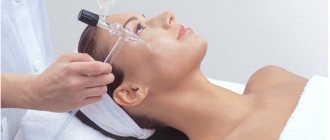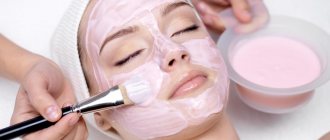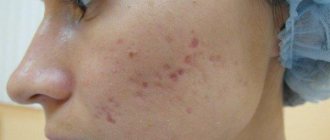The essence of the laser peeling procedure
The essence of the laser peeling procedure is to remove dead layers of skin, as a result of which cells begin to produce collagen and renew themselves. For laser resurfacing, 2 types of lasers :
- The erbium laser is designed to penetrate minimally into the layers of the skin and is even approved for use in the eye and lip areas.
- The CO-2 carbon dioxide laser is able to penetrate into deeper layers.
Laser peeling of superficial and median exposure is carried out using two methods :
- A cold laser acts on the skin layer by layer, without heating the lower layers.
- The hot laser exfoliates skin cells, warming the lower layers and stimulating metabolic processes in them, which is much more effective at improving skin elasticity.
Both procedures are performed by a qualified cosmetologist under local anesthesia .
The procedure is completed by applying an anesthetic to the skin, after which the patient can go home. With deep laser peeling, the carbon dioxide laser penetrates much deeper than with the first two methods, so the risk of possible complications is much higher. This procedure is performed under general anesthesia in a specialized clinic.
BEST CHEMICAL PEELINGS FOR SCARS
Chemical peeling for scars is based on acids that dissolve the upper layers of the epidermis along with rough connective tissue. Acids not only remove scars, but also have beneficial properties such as reducing the activity of the sebaceous glands.
We recommend: What to choose: CHEMICAL PEELING or LASER GRINDING?
Peeling TCA concentration 35-50%
In terms of its effect, peeling is classified as deep. The solution is applied to the problem area and left for 10-15 minutes. Trichloroacetic acid exfoliation effectively removes scar tissue while burning away any pathogens.
However, like any deep chemical exfoliation, TCA can cause swelling, hyperemia and allergic reactions. Recovery takes from 10 to 20 days.
Retinoic (yellow) peeling
The basis of yellow peeling is retinoic acid, which enhances the antibacterial properties of cells. Therefore, it is convenient to use on skin prone to inflammation.
The depth of action depends on the time for which the composition is left on the face or body. To effectively act on scar tissue, the yellow retinoic mixture must be left in place for at least 6 hours.
Phenolic
The effectiveness of exfoliation with phenolic acid has long been recognized. The depth of action varies from superficial to deep, depending on the concentration of the composition. In addition, phenol has a powerful antiseptic effect.
However, you should resort to phenol peeling only in the most extreme cases, since the drug is toxic and, with frequent use, depresses the nervous system.
What does your face look like immediately after laser peeling?
After laser peeling, redness and some swelling . Itching is also common as the skin undergoes healing processes. These symptoms last for about 3-5 days ; in some cases, this picture can last for 2-3 weeks . In general, laser peeling of superficial and medium penetration is very popular in cosmetology precisely because of the easy, fast and painless recovery period. Skin care during the rehabilitation period consists of applying cream at a certain frequency recommended by a cosmetologist. It happens that the consequences of laser peeling are redness, scars and age spots on the skin.
Advantages and disadvantages
Every day the popularity of this procedure is growing and there are more and more people wanting to do laser facial peeling every day. If you look at the list of advantages of this method of skin cleansing, this increase in popularity immediately becomes clear.
- Speed and efficiency. The result becomes visible immediately after the first procedure. Wrinkles immediately begin to disappear, and stretch marks and scars no longer hurt your eyes.
- Minimum trauma to the skin . Compared to other skin cleansing methods, laser peeling is the most controlled. The specialist knows exactly the depth of penetration, which helps minimize the risk of injury.
- Painless . The laser only affects the upper layers of the skin, which have long died off and do not have any nerve endings. Thanks to this, during the procedure, the patient does not feel anything, not even the slightest discomfort.
- No side effects . Of course, this point directly depends on the qualifications of the specialist to whom the patient turned, but in cases of contacting a qualified specialist, there are completely no side effects.
But as with all other procedures, this one also has disadvantages that cannot be ignored:
- Price. Laser peeling is a very expensive procedure, and not everyone can afford it. This is due to the cost of the equipment and the qualifications of the technician.
- You need to be confident in the doctor’s qualifications and his experience plays an important role.
- There is a large list of contraindications.
- Long recovery period after the procedure. At this time, going out into the world is practically impossible and constant treatment with special creams and products is required.
- Possibility of complications. Before the procedure, you need to carefully read the contraindications, otherwise, if even the slightest precaution is not taken, the consequences may be irreversible.
- The need to carry out a complex of procedures.
- Mandatory anesthesia.
Effective results of laser peeling
With superficial and medium laser peeling, the recovery period lasts approximately 7-10 days . With deep laser resurfacing - up to 3-4-6 months . During the recovery period there is no need to be in hospital if there are no prerequisites for this in the form of complications. After laser peeling you can get the following:
- More elastic and youthful skin .
- Improved blood circulation and complexion.
- Increased regenerative capacity by 25-30%.
- Reduction or removal of wrinkles and visible capillaries.
- Tightened facial contour.
- Elimination of minor skin defects.
- Reducing the size and visibility of large scars , including acne marks.
- Overgrowth of stretch marks with normal skin after several procedures over a period of approximately 1.5 months.
The results of deep laser peeling will fully manifest themselves only after 4-6 months , but at the same time they can delight you for up to several years. This is the time the rejuvenating effect lasts.
HOW TO DO PEELING FOR CUTS AND SCARS AT HOME
It is impossible to get rid of large and old scars on your own. However, at home you can carry out superficial exfoliation, which will allow you to cope with fresh, small defects.
Badyaga with hydrogen peroxide
This mask promotes the resorption of small scars and alleviates acne. In combination with hydrogen peroxide, badiaga has the following properties:
- Exfoliates the stratum corneum of the epidermis;
- Has a slight irritant effect on cells, provoking their protective reactions and forcing them to regenerate;
- Stimulates elastin production;
- Has anti-inflammatory properties;
- Resolves neoplasms;
- Effectively disinfects.
For the mask, you need to mix badyagu with hydrogen peroxide in a 1:1 ratio and leave until foam appears.
The mixture is applied overnight in a thin layer. In the morning after washing, moisturizing is not required, but it is advisable to treat the skin with sunscreen.
Skin resurfacing at home
Scrubs will help eliminate scars at the initial stage. You can buy them or make them yourself. When preparing it yourself, honey, sour cream, kefir, and vegetable oils are usually used as a basis, to which ground coffee fruit seeds, sugar or oatmeal are added. Rub the scrubs into the skin with light movements for 1-2 minutes and rinse off.
We recommend: 5 recipes for PUMPKIN PEELING
You can also carry out grinding at home using special devices for the following actions:
- Brushing - removal of the stratum corneum using brushes, the depth of exposure is determined by the stiffness of the bristles;
- Diamond peeling - works based on a combination of a vacuum pump and diamond-coated grinding attachments;
- Ultrasonic cleaning breaks molecular bonds in cells, loosening and exfoliating the top layer of the epidermis.
GEZATON, 150 € LW-006, 33 €
Masks for imperfections
It's easy to make masks at home that will help make fresh scars less noticeable. Compositions made from the following ingredients have proven themselves to be best:
- Honey-lemon – heat the honey and mix it with lemon juice in a 1:1 ratio, apply to the problem area, leave for 15 minutes;
- Clay – mix the yolk, the juice of half a lemon and a tablespoon of clay appropriate to your skin type, leave the mixture on the skin for 10-15 minutes;
- Aloe – mix 1 tablespoon of aloe juice with 1 teaspoon of lemon, apply to the skin for 10 minutes.
Complications and adverse reactions
The first complication is damage to the vascular wall, which leads to bleeding. If this happens, large areas of hematoma may appear on the skin.
If the laser device is not configured correctly, blisters filled with liquid contents (blood, lymph) may appear on the skin.
The skin can react to injury with the appearance of a strong inflammatory reaction, for example, the appearance of pustules or erysipelas, but this happens with individual intolerance.
The first couple of days after the procedure, swelling, redness and even itching may appear. These are side reactions that do not pose any danger and go away on their own.
Recovery period
Immediately after the procedure is stopped and the anesthesia wears off, you will feel your skin burning. The master will calm this strong burning sensation by applying panthenol, bepanten, dexapanthenol or any other product that is used for active regeneration and restoration of the skin after thermal and sunburn.
During the first day, the laser-treated skin will be red and you will experience severe burning and pain. Constant treatment with bepanthen and a fan will help. A stream of cool air will soothe the pain, as with any wound or burn. Ichor may be released, then the areas need to be treated with physical therapy. solution and chlorhexidine. It is strictly forbidden to go outside or apply cosmetics during this period. You will not only scare passers-by with your appearance, but you can also spread an infection.
On the second day, for most, the pain becomes much less severe. It is still necessary to treat the skin and apply Bepanthen frequently.
Due to the constant and abundant use of bepanthen, which is very greasy, large ulcers may appear. This is normal in the first days after laser.
After a week, the skin will calm down, pain and itching will stop completely, but slight redness may remain for a few more days. The effect after one procedure of such peeling is fully manifested after two to three months, because the laser starts the regeneration process, and then the cells start working on their own. For a couple of months after peeling, apply sunscreen to your skin, the same as you use in the summer when going to the beach. Otherwise you may end up with pigmentation.
How to choose the necessary procedure?
Laser peeling is suitable for young skin: it will eliminate the first age-related changes, help cope with inflammation and clogged pores, and give smoothness. Laser fractional resurfacing will cope with the problems of aging skin: loss of elasticity, thinning, deep wrinkles.
In addition, it is possible to combine two attachments in one procedure to enhance the effect: the full beam evens out the skin texture, and the fractional one promotes lifting and tightening.
Only a cosmetologist can choose a procedure that is suitable for you, after collecting anamnesis and analyzing the condition of the skin.
You can sign up for the procedure by calling or ordering a call back.
Contraindications
The procedure, unfortunately, is not available to everyone. There are a number of restrictions; they are divided into permanent (absolute) and temporary (relative). If the contraindications are permanent, then you should not undergo the procedure under any circumstances, otherwise you may seriously harm your health. Relative ones limit you only for a certain period of time.
Absolute contraindications to laser peeling:
- Diabetes. During this disease, normal wound healing is disrupted and trophic ulcers can form, which is very dangerous.
- Neurological problems, especially those associated with seizures (epilepsy).
- Congenital and acquired bleeding disorders.
- Chronic skin conditions such as rosacea. If you have dermatological problems, then first check with your doctor or cosmetologist whether you can have this procedure.
- Oncology. The body is in a constant state of stress, and all its forces are aimed at fighting the tumor. Also very often, powerful immunosuppressive therapy is carried out, due to which the immune system will be suppressed. The skin simply will not be able to recover and heal normally.
Relative contraindications:
- Infectious diseases in the acute phase. Especially those that occur with high fever and can be contagious.
- Herpes. When it goes into remission and all external manifestations disappear, you can safely perform the procedure.
- Pregnancy and lactation period. At this time, the body is working hard, the effect of the procedure will be insufficient, not to mention the fact that it can harm the child.
- The presence of fresh wounds and abrasions. Before laser peeling, you need to wait until they are completely healed.
- Taking medications that affect blood composition. You should also not take antibiotics or hormonal drugs.
- Inflammatory reactions on the skin, especially those accompanied by the formation of pus.
If all of the above contraindications are present, it is better to choose another cosmetic procedure; you can always find an option that suits you. Don't risk your health.
Expectation and reality: reviews of laser peeling
When resorting to the procedure, remember that the laser removes the top layer of cells or affects the dermis. Since the intervention is quite aggressive, you must prepare for how your face will look during the recovery period.
According to reviews, laser exfoliation allows you to get rid of small wrinkles, uneven pigmentation, acne scars, and bags under the eyes. But a lot depends on the skill of the dermatologist, so make sure he is qualified. Often disappointments are associated with the fact that the doctor did not warn about the need for additional sessions. When contacting a conscientious specialist, no complaints arise. You will see the peeling results in the photo.
Also make sure that the doctor understands what you want to get and considers the expectations realistic: most dissatisfied reviews are related to the fact that patients hoped for a dramatic transformation after 1 procedure. But the number of visits to the salon and the frequency of courses depend on the initial condition of the skin. In some cases, it is necessary to conduct up to 8 sessions with breaks of 45 days, which affects the price. The course is repeated every 2-5 years.
Factors that cause customer dissatisfaction include price: on average it is 12,000 rubles. per session. For this money you will receive treatment of the face, eyelids and upper neck. How much does laser peeling cost the entire neck and décolleté? You will have to pay 25,000 rubles.











